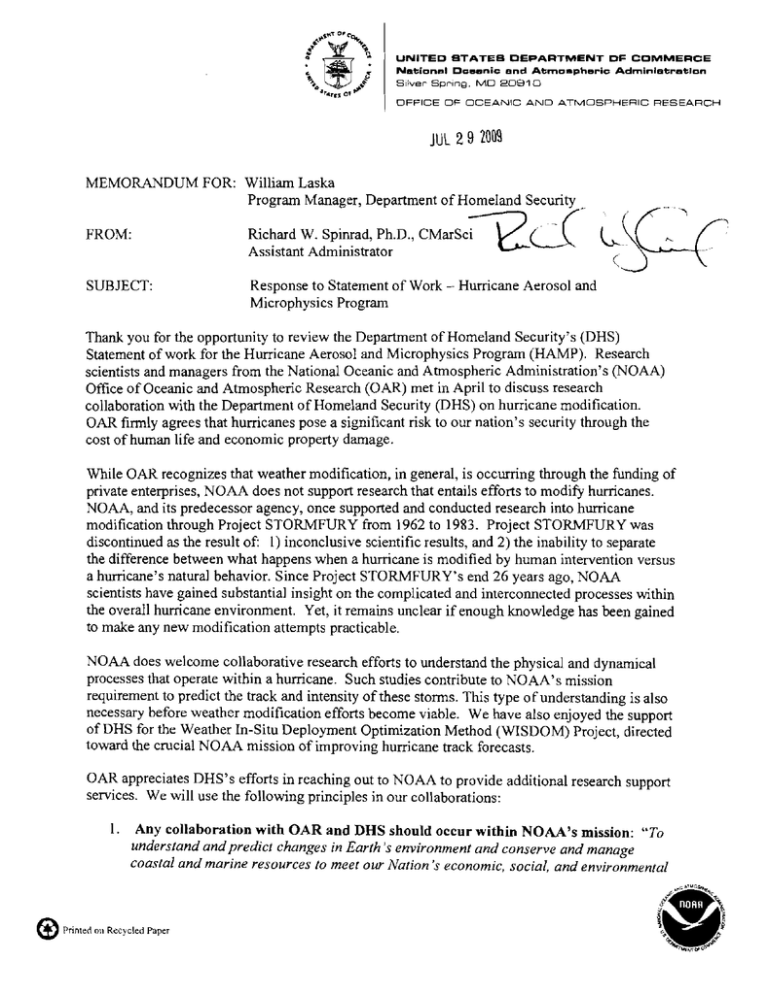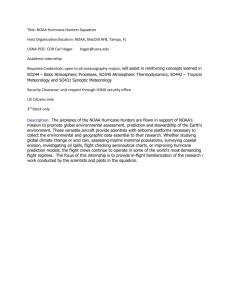-,., 1
advertisement

-,., -. UNITED BTATEB DEPARTMENT DF COMMERCE Nationml Dslanis and Atrno-phsri~ Adrninlatretlpn 1 OFFICE OF OCEANIC AND ATMOSPHERIC RESEARCH MEMORANDUM FOR: William Laska Program Manager, Department of Homeland Security FROM: Richard W. S p i ~ a dPh.D., , CMarSci Assistant Administrator SUBJECT: Response to Statement of Work - Hurricane Aerosol and Microphysics Program Thank you for the opportunity to review the Department of Homeland Security's (DHS) Statement of work for the Hurricane Aerosol and Microphysics Program (HAMP). Research scientists and managers from the National Oceanic and Atmospheric Administration's (NOAA) Office of Oceanic and Atmospheric Research (OAR) met in April to discuss research collaboration with the Department of Homeland Security @HS) on hurricane modification. OAR firmly agrees that hurricanes pose a significant risk to our nation's security through the cost of human life and economic property damage. While OAK recognizes that weather modification, in general, is occurring through the funding of private enterprises, NOAA does not support research that entails efforts to modify hurricanes. NOAA, and its predecessor agency, once supported and conducted research into hurricane modification through Project STORMFURY from 1962 to 1983. Project STORMFURY was discontinued as the result of: I) inconclusive scientific results, and 2) the inability to separate the difference between what happens when a hurricane is modified by human intervention versus a hurricane's natural behavior. Since Project STORMFURY's end 26 years ago, NOAA scientists have gained substantial insight on the complicated and interconnected processes within the overall hurricane environment. Yet, it remains unclear if enough knowledge has been gained to make any new modification attempts practicable. NOAA does welcome collaborative research efforts to understand the physical and dynamical processes that operate within a hurricane. Such studies contribute to NOAA's mission requirement to predict the track and intensity of these storms. This type of understanding is also necessary before weather modification efforts become viable. We have also enjoyed the support of DHS for the Weather In-Situ Deployment Optimization Method (WISDOM) Project, directed toward the crucial NOAA mission of improving hurricane track forecasts. OAR appreciates DHS's efforts in reaching out to NOAA to provide additional research support services. We will use the following principles in our collaborations: 1. Any collaboration with OAR and DHS should occur within NOAA's mission: "To understand and predict changes in Earth's environment and conserve and manage coasral and marine resources to meet our Nation S economic, social, and environmental needs." NOAA's research, conducted by programs within NOAA and through collaborations outside NOAA, focuses on enhancing our understanding of environmental phenomena. For hurricanes and other weather phenomena, NOAA research also focuses on improving predictions. 2. Any collaboration with OAR and DHS should be consistent with NOAA's current strategy. Responding to the NOAA Science Advisory Board Hurricane Intensity Research Working Group recommendations, the National Science Board report: "Hurricane Warning: The Critical Need for a National Hurricane Research Initiative", and the Office of the Federal Coordinator of Meteorological Services' (OFCM) "Interagency Strategic Plan for Tropical Cyclones - The Way Ahead", NOAA formed the Hurricane Forecast Improvement Project (HFIP) in 2007. HFIP outlined a 10-year project designed to accelerate improvements in one to five day forecasts for hurricane track, intensity, storm surge and to reduce forecast uncertainty. Because of importance to emergency management officials, an emphasis was placed on forecasting rapid intensity changes. 3. Any collaboration with OAR and DHS should leverage existing partnerships and processes. NOAA, through HFIP, has partnered with the U.S. Navy's Office of Naval Research, the National Aeronautics and Space Administration, the National Science Foundation, the Minerals Management Service, and the Department of Energy to better support the required research and development necessary to improve the operational hurricane track and intensity forecasts. This formally established hurricane alliance ensures coordination across the broad spectrum of activities from observations to data assimilation to modeling to basic research. Additionally, NOAA worked with the Office of the Federal Coordinator for Meteorology (OFCM) through the Working Group on Tropical Cyclone Research (WGiTCR) to coordinate research efforts related to tropical cyclones and to identify gaps in research efforts that may be important to improving prediction of tropical cyclones. Taking into consideration the above principles, OAR welcomes further research and development collaboration with DHS, and we look forward to any further discussions between NOAA and DHS experts on how we can collaborate on minimizing a hurricane's impact to our nation.





